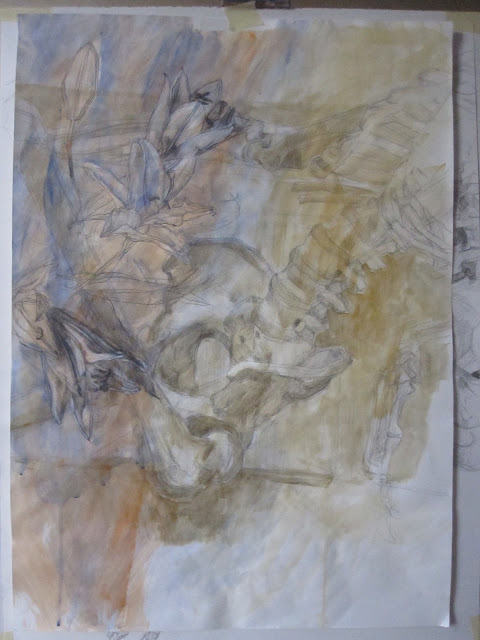Looking forward to seeing Audrey's exhibition at the vernissage this Friday in the Greene Gallery at St John's. I have followed her work as a friend since I came to Belgium 16 years ago and have been impressed with her honesty as a person, the quality of her work and integrity of the feelings and processes involved.
Audrey Atkinson:
Bodies of Work.
Audrey’s Atkinson’s paintings are
complex things built up over time in multiple layers with surfaces of linen, gesso
and paint that recall plastered or distempered walls. Embedded as collage
into these light absorbent and reflective surfaces are shadowy human forms
drawn in calligraphic gestural line drawings and sometimes organized in
sequences that recall the motion of film strips. These human traces, worked up
from sketches and drawings made over time from the live model are fixed into
the architecture of the paintings so as to juxtapose dynamic arabesques of
movement against the static geometry of the horizontal and vertical axis of the
picture plane, which acts like the frame of a door or window, a stage or
catwalk for the lines that dance or writhe in a kind of kin-aesthetic notation across
the surface before disappearing back into the surface. Complex formal tensions are played out
here between figure and ground, form and space, light and dark and rich
visceral blood reds, smeared or stained browns, and inky blacks against
bleached whites and creams. At first glance they appear aesthetically pleasing
and decorative but look closer and longer, contemplate them, and there is
something deeper, more disturbing, more rewarding happening here.
Audrey’s sketchbooks, etching and
engraving and painting have always had a unity and focus that made them an
integrated whole with one process flowing into another and developing a rich
interaction and symbiosis. More recently she has extended this approach into
three dimensions to include work in ceramics and mixed media, wire and cloth
assemblages in which the body plays a central role. Small carefully
modeled torsos and other fragments of the human form are draped with slip
soaked rags and fired to a hard, rough stone finish with burnt cinder qualities
that remind me of the figures from Pompei, frozen in the moment when the
volcanic ash buried them only to emerge from their ancient rock cocoons when
archeologists took casts by pouring plaster into the cavities to reveal their
moments of final surrender. The body is a cipher in which we can read
sensuality, pain, and the passage of time that both fixes, even as it erases,
the contortions and expressions of the creatures it captures in fossilized
stone.
In contrast to this hard sculptural
material her soft sculptures involve the more feminine act of sewing fragments
of cloth onto carefully constructed wire armatures that are based around the
shapes and forms of bones to create three dimensional rag collages that are
assembled from many separate parts to make partial or incomplete wholes rather
like fragments of bone from an exhumation in the forensic laboratory. Audrey’s
background in fashion is clearly evident in this use of materials but the
medical and forensic allusions resonate beyond the merely aesthetic and allude
to the body as damaged or outraged, in need of healing or justice. There is no
raw horror or sensation here, rather quiet and persistent questions about the
nature of truth, beauty, goodness.
Audrey’s art is the art of healing
through touching pain, a laying on of hands, literally, like touching the
earth. Her art is the art of fragmentation and decay even as it is an art of reconstruction
and restitution. Ultimately her work is a silent witness to the power of art to
transform our understanding of the human condition though forms of expression that
pre-empt written or verbal communication, the language of the senses, the language
of the body itself that is at once timeless and profound.










'_by_Ben_Nicholson,_Tate_Modern.JPG)




































